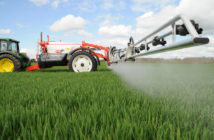Timing is key when desiccating oilseed rape as going on too early can impact quantity and quality of yields is the advice from Cam Murray, Hutchinsons northern technical manager.
Desiccating the crop before it is ready can damage the seed filling procedure and can also lead to an increase of red seeds due to uneven ripening. Anything more than 5% of red seeds will result in rejection issues, he reminds growers.
“The best guide for getting desiccation timing right is to go with the overall crop appearance – take particular notice of the seed colour,” he says.
“As a visual guide if the crop is ready for dessication, it should resemble the colour of a hares back. Samples should then be taken from the main raceme as this will ripen first. Take about 20 pods and if 2-3 have changed from green to brown then this the early timing and from this stage on glyphosate can be applied over the next 4-7 days.”
Only chemical option
“Glyphosate is now the only chemical option for desiccation with the loss of diquat. However, remember that seed moisture needs to be 30% or below for application and aim for about 14-20 days prior to harvest. It cannot be used on seed crops.”
Mr Murray recommends using robust rates – at least 1440 gms of active- and where a generic product is being used then be sure to use the required adjuvant.
“As glyphosate is very susceptible to cations in the water which can cause lock up of the active and reduction in the ability for the herbicide to work effectively, it’s worth adding an adjuvant that can condition the water and accelerate the uptake of the glyphosate.”
He adds the importance of reading the labels carefully with regards to rates.
“Remember that adjuvants have a growth stage cut off for use with 100% dose of pesticide.”
“If preferring a non-chemical route then swathing is an option – but really only tends to suit crops that are thick and are leaning. Its important when swathing to keep the swathed crop off the ground to allow for air flow.”
“Of course, if a crop is weed free and very even, there is the option to do nothing, and leave it to ripen naturally. This is useful if there are large areas of OSR to harvest and you are trying to spread out the harvest window. However, the crop will take longer to ripen which means this is not really an option the further north you go due to the lower temperatures and higher moisture levels.”
Top Tips for successful OSR desiccation
Timing is key: Don’t go too early as this will compromise yield and increase chances of crop rejection due to red seed
Crop should look like the colour of a hares back
Take 20 pods from main raceme and if 2/3 have changed from green to brown then glyphosate can go on in 4-7 days time
Use robust rates and an appropriate adjuvant to improve efficacy
Use a pod sealant to prevent pod shatter
Mechanical desiccation should only be used where crops are very thick and leaning




